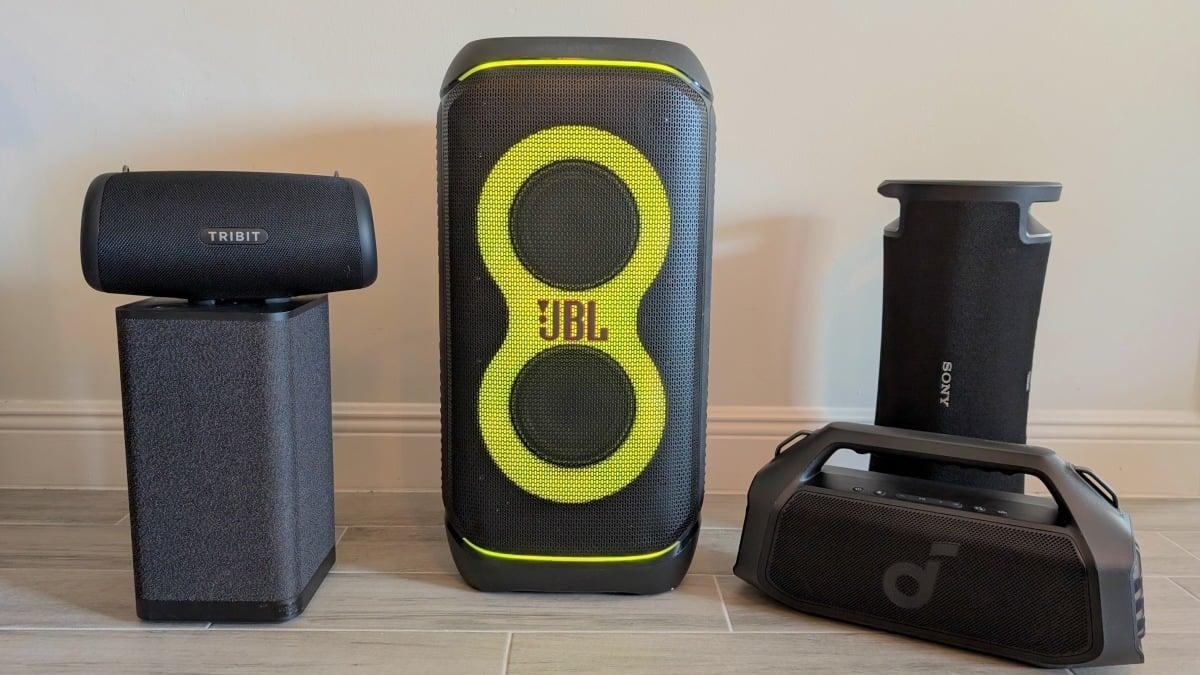If you love to host big gatherings, then the best party speakers are an absolute must.
You’re probably asking, “What’s the difference between standard Bluetooth speakers and party speakers?” There's no hard and fast definition, so let's just say we know it when we hear it.
Party speakers are more robust in size, specs, and bass. They’re engineered with bigger drivers and woofers to bump music at insanely high levels. The batteries in these models are higher capacity, and in some cases, can be swapped out to extend playtime. Some speakers even come with DJ features like instrument compatibility and RGB lights. While there's a lot of overlap between portable speakers and party speakers, we prioritize portability in the former (duh) and big, thumping sound in the latter.

Some of the speakers tested for this review.
Credit: Alex Bracetti / Mashable
The Mashable tech and shopping teams stay on top of the latest Bluetooth speaker releases, using our expertise and hands-on experiences to determine the market’s most favorable offerings. I've also personally tested dozens of speakers in the last couple years, focusing on features such as overall audio quality, battery life, portability, sturdiness, and whether they serve best for indoor or outdoor play (or both).
So, what is the best party speaker for summer 2025? Mashable’s top picks include the class-leading JBL PartyBox Stage 320, along with audio powerhouses like the Sony ULT Field 7 and Ultimate Ears Hyperboom.
Mashable developed this guide by sifting through our current and past party speaker reviews. In recent years, we've tested dozens of Bluetooth speakers from brands such as JBL, Sony, Marshall, LG, Beats, and Anker Soundcore. Here are the major factors we looked at when compiling our favorite party speakers:
Sound quality: We tested each speaker by playing different media formats, including audiobooks, music, movies, podcasts, and video games. When available, audio codecs and equalizer settings were cycled through to see how they impacted the sound of a speaker. Full volume range was also accounted for to examine balance and potential distortion of sound. Other notable sound features we checked out were adaptive audio modes, digital assistance (Alexa, Google Assistant, Siri), mono and stereo, and speakerphone capability.
Battery life: Our reviewers spent one week monitoring power levels through moderate use (4 to 5 hours daily) and a second week monitoring heavy use (more than 6 hours daily). This allowed them to properly assess how often a speaker needed to be recharged. Any models with a built-in power bank were used to portably recharge compatible devices (typically smartphones and tablets). Battery-draining culprits like multipoint, RGB lightning, and volume had been carefully watched as well.
Design: Craftsmanship and size were evaluated to see if a speaker was best suited for a bookshelf, desktop, entertainment system, or outdoor setting (e.g., balcony, patio). We looked at ingress protection (IP) ratings to verify dust-, dirt-, shock-, splash-, and water-resistant/proof claims. Any speakers with attachable or built-in handles were carried multiple times to observe how portable-friendly they were.
Connectivity: Most current party speakers run on Bluetooth 5.0 (or higher). Our reviewers paired each speaker to media devices operating on iOS/macOS, Android, and Windows. This provided a greater sense of compatibility. Range was tested by placing each speaker in different locations at a specified distance (up to 60 feet) from our connected audio source.
Value: Whether you’re spending $100 or $1,000, you want a party speaker that offers the most bang for your buck. Pricier options often come with high-end sound and special features. That doesn’t mean you can’t find less expensive options that perform similarly in certain areas. As we expand our testing pool, we’ll take into consideration how different speakers match up to their competitors.











